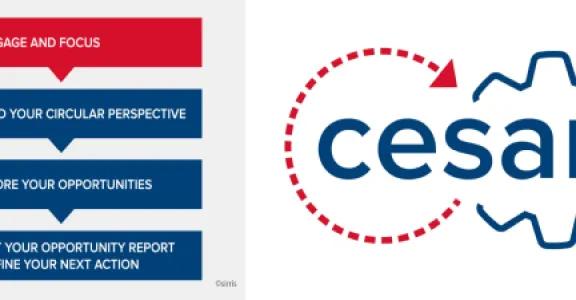Our newly developed Cesar Tool teaches you which opportunities you are already taking advantage of and where you can find extra value by fully exploiting the circular economy. We have opted for a four-step process.
Is this tool for you?
The Cesar Tool is aimed at companies that have an impact on a physical product. This is a very broad target group consisting of product designers, producers, sales and distribution, service providers in maintenance and repairs, collectors and resellers of products or components, dismantlers of discarded products and recyclers.
In a first step, we ask you to choose which product or product group you want to conduct the exercise for. A company that, for example, has both fixed and mobile machines in its portfolio should therefore choose one type, because the circular opportunities can be very different for both. For a mobile device, rental, shared use or resale may have a relevant potential, while fixed machines may have more value through remanufacturing and parts harvesting. The customer segment may also differ by product group. Each of the customer segments may have different needs, which of course makes other circular strategies meaningful. For example, products for sectors such as automotive, healthcare or construction will benefit from an approach tailored to their requirements.
Which perspective suits your company best?
The nature of your company's activities, products and services naturally also determines the degree of freedom of movement in the circular economy. Not every company should or can be the driving force behind a new circular value chain. The room for manoeuvre of a manufacturing company that supplies to OEMs and therefore has little impact on product design is different from a company that builds, installs and maintains its own stand-alone product design. Nevertheless, each company can play a role in the circular economy.
That is why we use the Cesar Tool to look for the opportunities that best suit your business activities. In a spider diagram we show the relative size of the opportunities in six axes:
- Product design, production and production efficiency, distribution, including the impact of material selection, production technology, lead time, production downtime, ...
- Product use, including product tracking & tracing, condition monitoring, usage profiles, data analyses, ...
- Maintenance and repair, including sale and installation of wear parts, upgrading of products (hardware and software), periodic cleaning, lubrication, ...
- Reuse and redistribution, including second-hand sales, resale, take-back of products, subsystems and platforms, ...
- Refurbishing and remanufacturing, including the upgrading of end-of-life products, remanufacturing products into new products, component re-use, ...
- Recycling, including separation of valuable materials, closing cycles, decontamination of materials, valuable secondary raw materials, ...
What are you already doing?
The next step is to identify all the good practices you are already using. By further focusing on this and combining it with new insights and opportunities, you can get off to a flying start. The qualitative questions will give you a broad picture of the aspects that matter to your company.
Just by thinking about all the questions for a moment, you will gain new insights and establish new links between what is valuable in your company and the circular objectives and opportunities associated with this. In this way, your detailed knowledge of your products, processes and services can potentially be of great value to other actors in the circular value chain. After all, no company can achieve the circular economy on its own.
For example, product knowledge and component supply will be essential for remanufacturing processes. On the other hand, remanufacturing can provide loads of information that is very useful for product design.
How the customised report helps increase your support base
Once all questions have been completed, we bring all the information together in a customised report. The report naturally contains the extent to which your company is taking advantage of the circular opportunities (spider diagram). Even more important than your score are the questions about strategy suggestions. Not to point you in the right direction, but to start the conversation within your organisation and to set attractive circular goals.
To help you do this, we also provide a series of tips & tricks based on the answers you have given. In this way you will obtain the most relevant information that you can use to plan your follow-up action.
Finally, we also give you some 'buzz words' that you can use to align the terminology used within your company and with your partners. After all, speaking the same language is very important in order to understand each other's expectations.
Tip : Let a few colleagues fill in the Cesar Tool independently and then discuss the similarities and differences. In this way you will get more involvement within the organisation and you will overcome the different perspectives, opportunities and good practices. Draw energy from this to set up follow-up steps.
Do you still experience obstacles that are difficult to overcome or do you prefer a tailor-made approach? Together with you, we can determine which support suits you best: an individual, collective or co-creative approach. Contact us!






